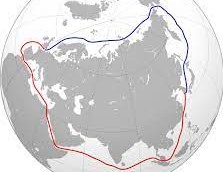8 April 2021
The Northeast Passage
Trade and conflict.
By Neil Tidmarsh
 The Ever Given has been re-floated, the Suez Canal has been unblocked, and by now – a week later – the backlog of 425 other cargo ships waiting to pass through must have been cleared. But the unfortunate Ever Given remains in the aptly-named Bitter Lake, more or less in detention, while the Suez Canal authorities wait for its owners to come up with $1 billion to compensate them for the cost of the salvage operation, stalled traffic and lost transit fees.
The Ever Given has been re-floated, the Suez Canal has been unblocked, and by now – a week later – the backlog of 425 other cargo ships waiting to pass through must have been cleared. But the unfortunate Ever Given remains in the aptly-named Bitter Lake, more or less in detention, while the Suez Canal authorities wait for its owners to come up with $1 billion to compensate them for the cost of the salvage operation, stalled traffic and lost transit fees.
Those costs must be worrying the owners and insurers of other cargo ships too. This vital artery linking east and west, carrying 12% of all the world’s trade, suddenly looks vulnerable and even unreliable. If a mere gust of wind can cause a week’s shut-down, with £290 million lost every hour, what could a real natural disaster or an armed conflict or a terrorist attack do? Everyone is suddenly remembering that the Canal was closed for almost a year after the 1956 crisis and for almost ten years after the Six-Day War of 1967.
Alternative routes must be under consideration. After the first few failed attempts to re-float the Ever Given, some of the many ships waiting at the southern entrance to the Canal opted for the long voyage round Africa instead. But that takes over two weeks, increases the cost of the voyage by hundreds of thousands of pounds, and runs the risk of pirate attack off Africa’s east coast and violent storms off the Cape of Good Hope. Surely there should be another alternative?
President Putin and Russia have been working on an answer to that question for the last twelve years. It’s an old question, admittedly, and the answer they’re working on is just as old. In the sixteenth century, European merchants and explorers such as Hugh Willoughby and Vitus Bering sought a Northeast Passage to the riches of the Far East – a sea route along the northern coast of Russia. But such attempts came to nothing; their voyages took them inside the Arctic Circle, of course, and they were defeated by seas which were frozen solid for most of the year or even all year round.
Climate change and the melting of the Arctic ice-cap, however, mean that this Northeast Passage may soon be viable as a major route for global trade, an alternative corridor between Europe and Asia to rival the one which uses the Suez Canal. The crisis of global warming has given Russia an opportunity and the Kremlin is determined to make the most of it. It recently launched a nuclear-powered ice-breaker to open up a route through the previously-impenetrable but now ever-thinner Arctic ice. Ice-breakers may not be needed for much longer, at least not all the year round; each winter sees less ice frozen over and each summer sees more ice melting. The route – now known as the Northern Sea Route – would also make it easier for Russia to extract and export the vast mineral resources of its frozen north, now accessible because of melting permafrost in Siberia and elsewhere.
But would this route be more secure and stable than the Suez Canal? Hardly. It runs right through what threatens to be one of the major conflict zones of the twenty-first century.
With climate change revealing the previously hidden wealth of the Arctic, Russia has been tempted to extend its power ever further northwards to grab those resources. Twelve years ago, a Russian submarine planted a Russian flag made out of titanium on the sea bed more than two miles beneath the North Pole to claim “The Arctic is Russian”. It isn’t the only country making such claims, of course, so in recent years it’s been preparing a capability for backing up those claims by force. It has re-opened Arctic airbases (unused since the Soviet era) and moved missiles north of the Arctic Circle. Last month, three Russian nuclear-powered submarines surfaced simultaneously through thick Arctic ice in an ostentatious display of regional power.
Further preparations were in the news this week. Huge military manoeuvres are currently underway near Alexandra Land in the Franz Josef Land archipelago in the Arctic Ocean. According to reports, they involve more than forty separate exercises, including tests of the Pantsir-S1 anti-aircraft system, mid-air refuelling of MiG 31 fighter jets, and the defensive jamming of hostile drones.
The Russian military also announced that it is conducting tests of Tsirkon anti-ship hypersonic cruise missiles in the Arctic. Analysts believe that it’s also testing the Poseidon 2M39 missile – the so-called “doomsday nuke” underwater drone which can travel up to 10,000km to destroy coastal cities with radioactive tsunamis – prior to deploying it in the Arctic next year. The Pentagon announced that satellite imagery recently taken by the space technology company Maxar suggests that Russia is building facilities on the Kola Peninsula inside the Arctic Circle to accommodate such weapons.
It’s a harsh irony, a cruel coincidence, that major shipping routes seem to pass through the areas of the globe most prone to conflict and instability: the Suez Canal, in the Middle East, hit time and again by the Arab/Israeli wars of the last century; the Northeast Passage to become viable just as the world’s powers square up to each other over the Arctic’s revealed treasures in the coming century; and China’s continuing militarisation of the disputed South China Sea. (This week, US secretary of state Antony Blinken urged allies Australia, Japan, South Korea, the EU and Nato to protect freedom of navigation against Chinese aggression; and a fleet of over 220 Chinese ships – a fishing fleet, according to Beijing, but a fleet of paramilitary naval vessels according to most observers – is currently surrounding the Whitsun Reef in the Spratley Islands, much to the dismay of the Philippines and other countries which also claim the territory.)
Perhaps it’s inevitable, given that such routes are strategically important and geopolitically valuable by their very nature. But it does mean that the fabled Northeast Passage, if and when it gets underway, might present future Ever Givens with something even more hazardous than an unexpected gust of wind and an inconvenient sandbank.
Tile photo: Collin Knopp-Schwyn and Turkish Flame, GNU Free Documentation.


